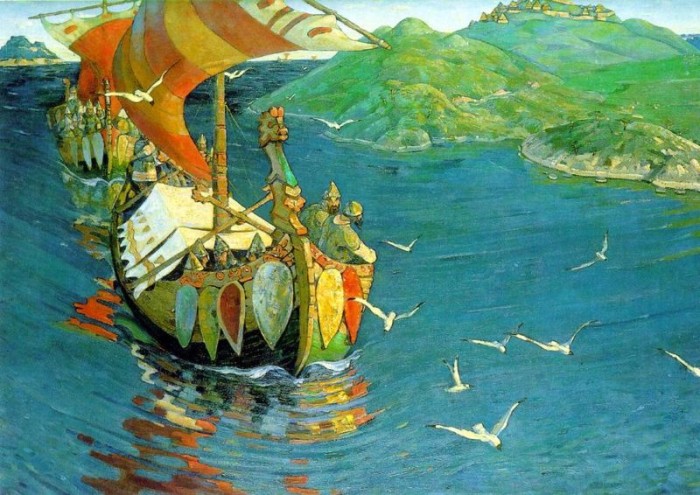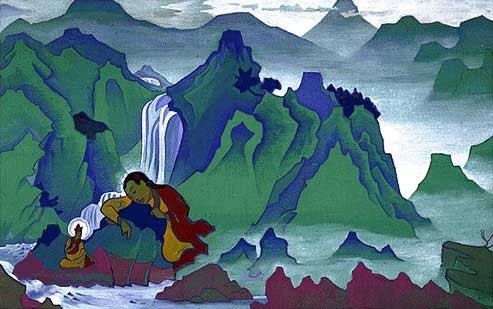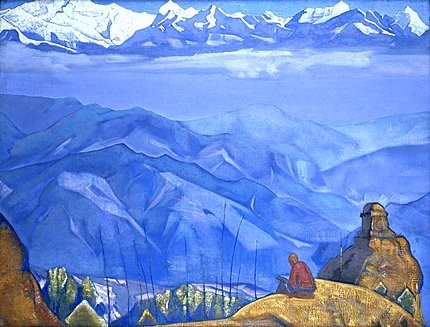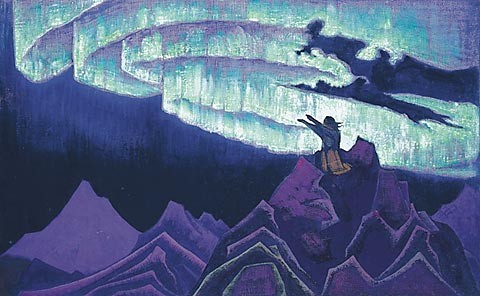Nicholas Roerich (1874-1947)
Get a Roerich Certificate of Authenticity for your painting (COA) for your Roerich drawing.
For all your Roerich artworks you need a Certificate of Authenticity (COA) in order to sell, to insure or to donate for a tax deduction.
Getting a Roerich Certificate of Authenticity (COA) is easy. Just send us photos and dimensions and tell us what you know about the origin or history of your Roerich painting or drawing.
If you want to sell your Roerich painting or drawing use our selling services. We offer Roerich selling help, selling advice, private treaty sales and full brokerage.
We have been authenticating Roerich and issuing certificates of authenticity since 2002. We are recognized Roerich experts and Roerich certified appraisers. We issue COAs and appraisals for all Roerich artworks.
Our Roerich paintings and drawings authentications are accepted and respected worldwide.
Each COA is backed by in-depth research and analysis authentication reports.
The Roerich certificates of authenticity we issue are based on solid, reliable and fully referenced art investigations, authentication research, analytical work and forensic studies.
We are available to examine your Roerich painting or drawing anywhere in the world.
You will generally receive your certificates of authenticity and authentication report within two weeks. Some complicated cases with difficult to research Roerich paintings or drawings take longer.
Our clients include Roerich collectors, investors, tax authorities, insurance adjusters, appraisers, valuers, auctioneers, Federal agencies and many law firms.
We perform Nicholas Roerich art authentication, appraisal, certificates of authenticity (COA), analysis, research, scientific tests, full art authentications. We will help you sell your Nicholas Roerich or we will sell it for you.

Nicholas Roerich was a Russian painter and spiritual teacher. He was the father of Tibetologist George Roerich (a.k.a. Yuri Roerich) and artist Svetoslav Roerich. Nicholas and his wife Helena Roerich were co-founders of the theosophical Agni Yoga Society. Born in pre-revolutionary St. Petersburg, Russia to the family of a well-to-do notary public, he lived around the world until his death in Punjab, India. Trained as an artist and a lawyer, his interests lay in literature, philosophy, archaeology and especially art.

In his early life Nicholas Roerich had close ties to Ukraine and Ukrainian culture. Influenced by such prominent Ukrainian symphatics of his time as Taras Shevchenko, Gogol, Kostomarov he had recognized Kobzar as one of his favorite books. [1]. His first painting classes N.Roerich got in the same memorial class where Shevchenko did. Inbetween 1903-06 Rerich’s drafts Pokrova was implemented in Kyiv region, in 1910 mosaic for Troyicky cathedral in famous Pechersk Lavra.

Roerich’s stage-designs for the premiere of Igor Stravinsky’s The Rite of Spring, given in Paris in 1913, and based on ancient Russian motifs, were highly innovative and influential. They were an important element in the success and the scandal of this epochal musical event. He first visited New York City in 1920. After touring the United States, he and his wife settled in the city, founding the Master Institute of the United Arts, They also joined various theosophical societies and their activities in these groups dominated their lives.
.jpg)
After leaving New York, the Roerichs – together with their son George and six friends – went on the five-year long ‘Roerich American Expedition’ that, in Roerich’s own words: “started from Sikkim through Punjab, Kashmir, Ladakh, Karakorem mountains, Khotan, Kashgar, Qara Shar, Urumchi, Irtysh, Altai Mountains, Oryot region of Mongolia, Central Gobi, Kansu, Tsaidam, Tibet.” with a detour through Siberia to Moscow in 1926. Between Summer 1927 and June 1928 the expedition was thought to be lost, since all contact from them ceased for a year. They had been attacked in Tibet and only the “Superiority of our firearms prevented bloodshed. … In spite of Tibet passports, expedition forcibly stopped by Tibetan authorities”. The Expedition was detained by the government for five months, and forced to live in tents in sub-zero conditions and meagre rations. Five men of the expedition died at this time. In March of 1928 they were allowed to leave Tibet, and trekked south to settle in India, where they founded a research center, the Himalayan Research Institute.

In 1929 Nicholas Roerich was nominated for the Nobel Peace Prize by the University of Paris. (He received a second nomination in 1935.) His concern for peace led to his creation of the Pax Cultura, the “Red Cross” of art and culture. His work in this area also led the United States and the twenty other members of the Pan-American Union to sign the Roerich Pact on April 15, 1935 at the White House. The Roerich Pact is an early international instrument protecting cultural property.

U.S. Vice-President Henry A. Wallace was a frequent correspondent and sometime follower of Roerich’s teachings, which caused some controversy when Wallace ran for President in 1948 and portions of the letters were printed by Hearst Newspapers columnist Westbrook Pegler.

Today, the Nicholas Roerich Museum in New York City is the artistic center of Roerich’s work. Numerous Rerikh societies continue to promote his theosophical teachings worldwide. His painting can be seen in several museums including the Roerich Department of the State Museum of Oriental Arts in Moscow; the Roerich Museum at the International Centre of the Roerichs in Moscow; the State Russian Museum in St. Petersburg, Russia; a collection in the Tretyakov Gallery in Moscow; a collection in the Art Museum in Novosibirsk, Russia; a collection in the Art Museum in Nizhny Novgorod, Russia the Roerich Hall Estate in Kullu Valley, Himachal-Pradesh (India); in various art museums in India; and a selection featuring several of his larger works in The Latvian National Museum of Art.

A recent source of information about the spiritual journeys of Nicholas and Helena Roerich is a book called “Nicholas & Helena Roerich, The Spiritual Journey of Two Great Artists & Peacemakers” by Ruth Drayer. Also see Jacqueline Decter’s biography, “Messenger of Beauty”; Kenneth Archer, “Nicholas Roerich: East and West”; and scholarly articles by John McCannon, as well as his “Searching for Shambhala,” in the magazine “Russian Life.”

Later developments have shown that Roerich tried to begin a new country made up of parts of Tibet, Mongolia, China and Russia. His wife, Mme. Helena Roerich wrote a book detailing how such a country should be governed by N. Roerich. Called “The Leader,” it has been translated from Russian to English by Gleb Drobychev and Gurt Wilson. Still wondering about a Russian painting in your family collection? Contact us…it could be by Nicholas Roerich.
Reviews
1,217 global ratings
5 Star
4 Star
3 Star
2 Star
1 Star
Your evaluation is very important to us. Thank you.
